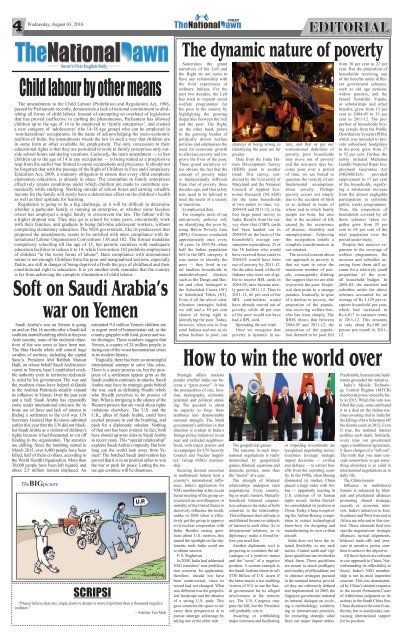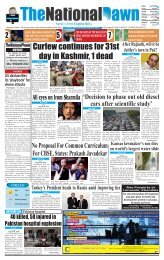You also want an ePaper? Increase the reach of your titles
YUMPU automatically turns print PDFs into web optimized ePapers that Google loves.
4<br />
Wednesday, <strong>August</strong> <strong>03</strong>, <strong>2016</strong><br />
EDITORIAL<br />
The dynamic nature of poverty<br />
Child labour by other means<br />
The amendments to the Child Labour (Prohibition and Regulation) Act, 1986,<br />
passed by Parliament recently, demonstrate a lack of national commitment to abolishing<br />
all forms of child labour. Instead of attempting an overhaul of legislation<br />
that has proved ineffective in curbing the phenomenon, Parliament has allowed<br />
children up to the age of 14 to be employed in ‘family enterprises’, and created<br />
a new category of ‘adolescents’ (the 14-18 age group) who can be employed in<br />
‘non-hazardous’ occupations. In the name of acknowledging the socio-economic<br />
realities of India, the amendments tweak the law in such a way that children are<br />
in some form or other available for employment. The only concession to their<br />
educational rights is that they are permitted to work in family enterprises only outside<br />
school hours and during vacations. Curiously, the main amendment — to ban<br />
children up to the age of 14 in any occupation — is being touted as a progressive<br />
leap from the earlier ban limited to some occupations and processes. It should not<br />
be forgotten that with the passage of the Right of Children to Free and Compulsory<br />
Education Act, 2009, a statutory obligation to ensure that every child completes<br />
elementary education, is already in place. The exemption to family enterprises<br />
effectively retains conditions under which children are made to contribute economically<br />
while studying. Working outside of school hours and earning valuable<br />
income for the family will surely have a deleterious effect on the children’s health<br />
as well as their aptitude for learning.<br />
Regulation is going to be a big challenge, as it will be difficult to determine<br />
whether a particular family is running an enterprise, or whether some faceless<br />
owner has employed a single family to circumvent the law. The fallout will be<br />
a higher dropout rate. They may go to school for some years, concurrently work<br />
with their families, and graduate to being full-time adolescent workers, without<br />
completing elementary education. The NDA government, like its predecessor that<br />
proposed the amendments, seems to be satisfied with mere compliance with International<br />
Labour Organisation Conventions 138 and 182. The former mandates<br />
compulsory schooling till the age of 15, but permits countries with inadequate<br />
education facilities to reduce it to 14, while Convention 182 prohibits employment<br />
of children “in the worst forms of labour”. Bare compliance with international<br />
norms is not enough. Children from the poor and marginalised sections, especially<br />
Dalits, are still in danger of being deprived of both the joys of childhood and their<br />
constitutional right to education. It is yet another stark reminder that the country<br />
is far from achieving the complete elimination of child labour.<br />
Soft on Saudi Arabia’s<br />
war on Yemen<br />
Saudi Arabia’s war on Yemen is going<br />
on and on. But 16 months after a Saudi-led<br />
coalition started bombing rebels in the poor<br />
Arab country, none of the declared objectives<br />
of the war seem to have been met.<br />
The Shia Houthi rebels still control huge<br />
swathes of territory, including the capital<br />
Sana’a. President Abd Rabbuh Mansur<br />
Hadi, on whose behalf Saudi Arabia intervened<br />
in Yemen, hasn’t established credible<br />
authority even in territories technically<br />
ruled by his government. The war and<br />
the resultant chaos have helped al-Qaeda<br />
in the Arabian Peninsula steadily expand<br />
its influence in Yemen. Over the past year<br />
and a half, Saudi Arabia has repeatedly<br />
come under international criticism for its<br />
brute use of force and lack of interest in<br />
finding a settlement to the civil war. UN<br />
Secretary General Ban Ki-moon admitted<br />
earlier this year that the UN did not blacklist<br />
Saudi Arabia as a violator of children’s<br />
rights because it had threatened to cut off<br />
funding to the organisation. The statistics<br />
are chilling. Since the bombing started in<br />
March 2015, over 6,400 people have been<br />
killed, half of them civilians, according to<br />
the World Health Organisation. More than<br />
30,000 people have been left injured, and<br />
about 2.5 million remain displaced. An<br />
TheBIGpicture<br />
estimated 9.4 million Yemeni children are<br />
in urgent need of humanitarian aid, as the<br />
country grapples with food, power and water<br />
shortages. These numbers suggest that<br />
Yemen, a country of 24 million people, is<br />
facing one of the worst humanitarian crises<br />
in its modern history.<br />
Tragically, there has been no meaningful<br />
international attempt to solve this crisis.<br />
There is a peace process on, but the prospects<br />
of a settlement appear grim as the<br />
Saudi coalition continues its attacks. Saudi<br />
Arabia may have its strategic goals behind<br />
the war, such as defeating Houthi rebels<br />
who Riyadh perceives to be proxies of<br />
Iran. What is intriguing is the silence of the<br />
Western powers that are vocal about rights<br />
violations elsewhere. The U.S. and the<br />
U.K., allies of Saudi Arabia, could have<br />
exerted pressure to end the bombing, and<br />
push for a diplomatic solution. Nothing<br />
of that sort has been evident. In fact, both<br />
have shored up arms sales to Saudi Arabia<br />
in recent years. This “special relationship”<br />
explains Saudi Arabia’s impunity. But how<br />
long can the world look away from Yemen?<br />
The botched Saudi intervention has<br />
proved that it is in no position either to win<br />
the war or push for peace. Letting the status<br />
quo continue will be disastrous.<br />
SCRIPSI<br />
“Please believe that one single positive dream is more important than a thousand negative<br />
realities.”<br />
~ Adeline Yen Mah<br />
Sometimes the grand<br />
narratives of the Left and<br />
the Right do not seem to<br />
have any relationship with<br />
the lived experiences of<br />
ordinary Indians. For the<br />
past two decades, the Left<br />
has tried to expand social<br />
welfare programmes for<br />
the poor in the country by<br />
highlighting the growing<br />
disparities between the rich<br />
and the poor. The Right,<br />
on the other hand, points<br />
to the growing burden of<br />
politically driven welfare<br />
policies and emphasises the<br />
need for economic growth<br />
to alleviate poverty and improve<br />
the lives of the poor.<br />
These grand narratives often<br />
obviate the fact that the<br />
concept of poverty today<br />
is fundamentally different<br />
from that of poverty three<br />
decades ago, and that safety<br />
nets need to be tailored to<br />
meet the needs of a society<br />
in transition.<br />
Complicated data<br />
For example, most of our<br />
anti-poverty policies rely<br />
on identifying the poor by<br />
using Below Poverty Line<br />
(BPL) Censuses conducted<br />
approximately once every<br />
10 years. In 1993-94, when<br />
half the Indian population<br />
fell in the BPL category, it<br />
was easier to identify the<br />
poor — they lived in rural<br />
landless households in<br />
underdeveloped districts<br />
such as the Dangs and Bastar<br />
and often belonged to<br />
the Scheduled Castes (SC)<br />
or Scheduled Tribes (ST).<br />
Even if all the above identification<br />
strategies failed,<br />
we still had a 50 per cent<br />
chance of being right in<br />
identifying the poor. Today,<br />
however, when one in four<br />
rural Indians and one in six<br />
urban Indians is poor, our<br />
Strategic affairs analysts<br />
ponder whether India can become<br />
a “great power”. It has<br />
the prerequisites of size, location,<br />
demography, economic<br />
potential and political standing.<br />
The question is about<br />
its capacity to forge these<br />
attributes into demonstrable<br />
national strength. The Modi<br />
government’s ambition in that<br />
direction is evident in India’s<br />
foreign policy initiatives in our<br />
near and extended neighbourhood,<br />
with major powers and<br />
in campaigns for UN Security<br />
Council and Nuclear Suppliers’<br />
Group (NSG) membership.<br />
Securing desired outcomes<br />
in multilateral forums tests a<br />
country’s international influence.<br />
India’s application for<br />
NSG membership at the recent<br />
Seoul meeting of the group encountered<br />
an unwillingness or<br />
inability of the United States to<br />
decisively influence the result,<br />
unlike in 2008 when it effectively<br />
got the group to approve<br />
civil nuclear cooperation with<br />
India. Besides raising questions<br />
about U.S. motives, this<br />
turned the spotlight on the diplomatic<br />
tools India could use<br />
to obtain success.<br />
P. S. Raghavan<br />
In 2008, India had addressed<br />
NSG members’ non-proliferation<br />
concerns. Its application,<br />
therefore, should not have<br />
been controversial, since its<br />
record had not changed. What<br />
was different was the geopolitical<br />
landscape and the absence<br />
of a strong U.S. push. This<br />
gave countries the space to advance<br />
their perspectives or to<br />
pursue strategic advantage by<br />
taking one or the other side.<br />
The geopolitical games<br />
The outcome in such international<br />
negotiations is really<br />
determined by geopolitical<br />
games, bilateral equations and<br />
domestic politics, more than<br />
the “merits” of a case.<br />
The strength of bilateral<br />
relationships underpins such<br />
negotiations. Every country,<br />
big or small, matters. Mutually<br />
beneficial bilateral cooperation<br />
enhances the stake of both<br />
countries in the relationship.<br />
This influences their attitude in<br />
multilateral forums on subjects<br />
of interest to each other. As in<br />
interpersonal relations, so in<br />
diplomacy: make a friend before<br />
you need him.<br />
Another diplomatic tool is<br />
projecting to countries the advantages<br />
of a positive stance<br />
and the “costs” of a negative<br />
position. A current example is<br />
the Saudi Arabian threat to sell<br />
$750 billion of U.S. assets if<br />
the latter enacts a law enabling<br />
victims of 9/11 to sue the Saudi<br />
government for its alleged<br />
involvement in the terrorist<br />
act. The U.S. Congress may<br />
pass the bill, but the President<br />
will probably veto it.<br />
Awarding or withholding<br />
major contracts and facilitating<br />
chances of being wrong in<br />
identifying the poor are far<br />
greater.<br />
Data from the India Human<br />
Development Survey<br />
(IHDS) point to another<br />
trend. This survey, conducted<br />
by the University of<br />
Maryland and the National<br />
Council of Applied Economic<br />
Research (NCAER)<br />
for the same households<br />
at two points in time, viz.<br />
2004-05 and 2011-12, is the<br />
first large panel survey in<br />
India. Results from the survey<br />
show that if BPL cards<br />
had been handed out in<br />
2004-05 on the basis of the<br />
household’s average consumption<br />
expenditure, 25 of<br />
the 38 Indians who would<br />
have received these cards in<br />
2004-05 would have been<br />
out of poverty by 2011-12.<br />
On the other hand, of the 62<br />
Indians who were not eligible<br />
to receive BPL cards in<br />
2004-05, nine became newly<br />
poor in 2011-12. Thus in<br />
2011-12, 66 per cent of the<br />
BPL card-holders would<br />
have already moved out of<br />
poverty, while 40 per cent<br />
of the poor would not have<br />
had a BPL card.<br />
Spreading the net wide<br />
Once we recognise that<br />
poverty is dynamic in nature,<br />
and that as per our<br />
conventional definition of<br />
poverty, poor households<br />
may move out of poverty<br />
and the non-poor may become<br />
poor over a period<br />
of time, we are forced to<br />
question the veracity of our<br />
fundamental assumptions<br />
about poverty. Perhaps<br />
poverty occurs not simply<br />
due to the accident of birth<br />
or as defined in terms of<br />
where and in which family<br />
people are born, but also<br />
due to the accident of life<br />
caused by the occurrence<br />
of disease, disability and<br />
unemployment. Achieving<br />
this recognition entails a<br />
complete transformation in<br />
our mindset.<br />
The second concern about<br />
our approach to poverty is<br />
that we want to cover the<br />
maximum number of people,<br />
consequently diluting<br />
the support that we are able<br />
to provide the poor. Empirical<br />
data point to a strange<br />
paradox. Ironically, in spite<br />
of a decline in poverty, the<br />
proportion of the population<br />
receiving welfare benefits<br />
has risen sharply. The<br />
IHDS shows that between<br />
2004-05 and 2011-12, the<br />
proportion of the population<br />
deemed to be poor fell<br />
or impeding investments are<br />
recognised negotiating tactics.<br />
Countries leverage strategic<br />
import decisions — civilian<br />
and defence — to extract benefits<br />
from the exporting country.<br />
In the 1990s, when Boeing<br />
dominated its market, China<br />
placed a large order with Airbus<br />
— apparently reacting to<br />
U.S. criticism of its human<br />
rights record. Airbus thereafter<br />
consolidated its position in<br />
China. Today, China is exploiting<br />
the Airbus-Boeing competition<br />
to extract technological<br />
know-how for designing and<br />
manufacturing its own civilian<br />
aircraft.<br />
India does not have the internal<br />
flexibility to use such<br />
tactics. Central audit and vigilance<br />
guidelines are invoked to<br />
block them. These guidelines<br />
are meant to check profligacy<br />
and venality of officialdom; not<br />
to obstruct strategies pursued<br />
in the national interest, provided<br />
they are coherently defined<br />
and implemented. In 20<strong>03</strong>, the<br />
Vajpayee government initiated<br />
an internal dialogue on evolving<br />
a methodology, conforming<br />
to international practices,<br />
for extracting strategic value<br />
from our major import orders.<br />
from 38 per cent to 22 per<br />
cent. But the proportion of<br />
households receiving any<br />
of the benefits under different<br />
government schemes,<br />
such as old age pension,<br />
widow pension, and the<br />
Janani Suraksha Yojana,<br />
or scholarships and other<br />
benefits, grew from 13 per<br />
cent in 2004-05 to 33 per<br />
cent in 2011-12. The proportion<br />
of households buying<br />
cereals from the Public<br />
Distribution System (PDS),<br />
which was intended to provide<br />
subsidised foodgrains<br />
to the poor, grew from 27<br />
to 52 per cent. Further, the<br />
newly initiated Mahatma<br />
Gandhi National Rural Employment<br />
Guarantee Act<br />
(MGNREGA) provided<br />
employment to 17 per cent<br />
of the households, signifying<br />
a substantial increase<br />
from the almost negligible<br />
participation in erstwhile<br />
public works programmes.<br />
Thus, the proportion of<br />
households covered by all<br />
these schemes taken together<br />
grew from 35 per<br />
cent to 68 per cent of the<br />
total population over the<br />
period under study.<br />
Despite this massive expansion<br />
in the coverage of<br />
welfare programmes, the<br />
incomes and subsidies accruing<br />
from them still account<br />
for a relatively small<br />
proportion of the overall<br />
household budget. In<br />
2004-05, the transfers and<br />
subsidies under the above<br />
schemes accounted for an<br />
average of Rs.3,129 per recipient<br />
household per year,<br />
which had increased to<br />
Rs.6,017 in constant terms<br />
in 2011-12. This amounts<br />
to only about Rs.100 per<br />
person per month in 2011-<br />
12.<br />
How to win the world over<br />
Predictably, bureaucratic headwinds<br />
grounded the initiative.<br />
India’s Missile Technology<br />
Control Regime (MTCR)<br />
membership was vetoed by Italy<br />
in 2015. When this veto was<br />
lifted this year, some attributed<br />
it to a deal on the Italian marines<br />
awaiting trial in India for<br />
the killing of two fishermen off<br />
the Kerala coast in 2012. Even<br />
if true, the national interest<br />
justifies such deals. Similarly,<br />
every time our government<br />
signs a multilateral agreement,<br />
it faces charges of a “sell-out”.<br />
The truth that you must concede<br />
somewhere to get something<br />
elsewhere is as valid in<br />
international negotiations as in<br />
daily life.<br />
The China lessons<br />
Influence in multilateral<br />
forums is enhanced by bilateral<br />
and plurilateral alliances<br />
promoting shared strategic,<br />
security or economic interests.<br />
India’s initiatives in East,<br />
Southeast and West Asia and in<br />
Africa are relevant in this context.<br />
These elements feed into<br />
specific negotiations: strategic<br />
alliances, tactical alignments,<br />
bilateral trade-offs and pressure<br />
at sensitive points combine<br />
to achieve the objective.<br />
All these factors are relevant<br />
in our approach to China. Notwithstanding<br />
its inflexibility at<br />
Seoul, India’s NSG membership<br />
is not its most important<br />
concern. This was demonstrated<br />
by China’s strident response<br />
to the recent Permanent Court<br />
of Arbitration judgment on its<br />
actions in the South China Sea.<br />
China dismisses the court’s authority,<br />
but is assiduously canvassing<br />
international support<br />
for its position.
















